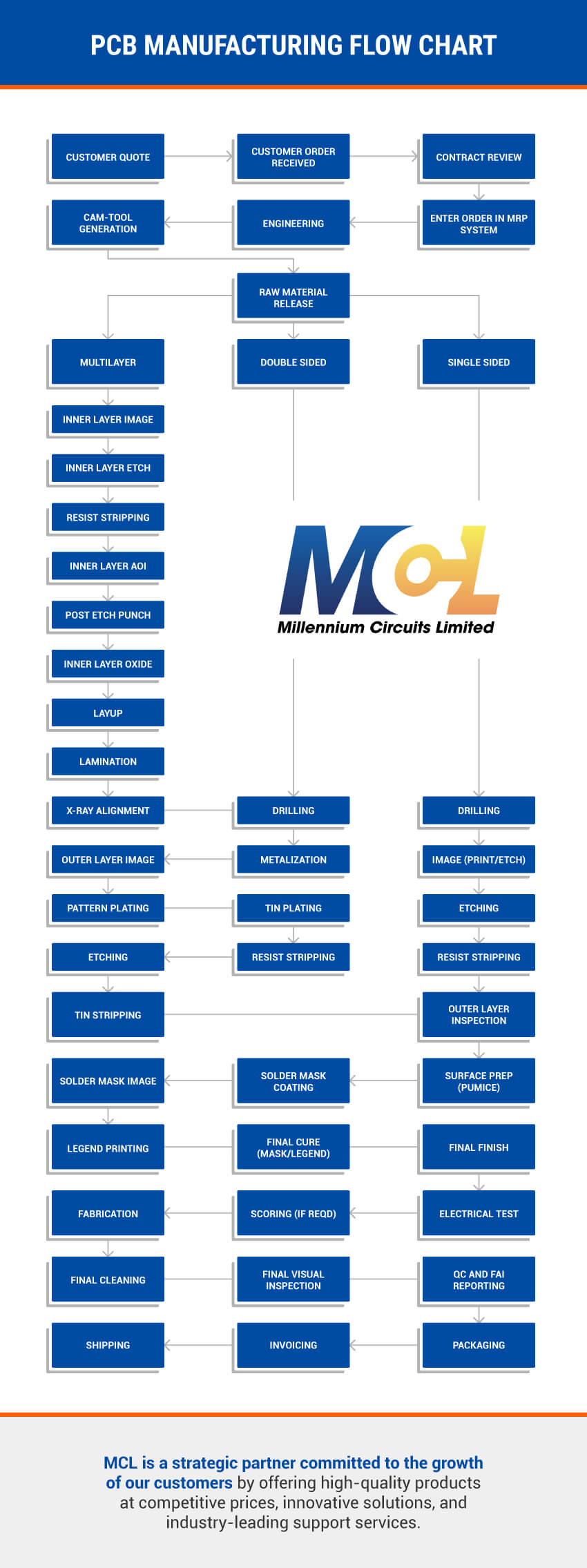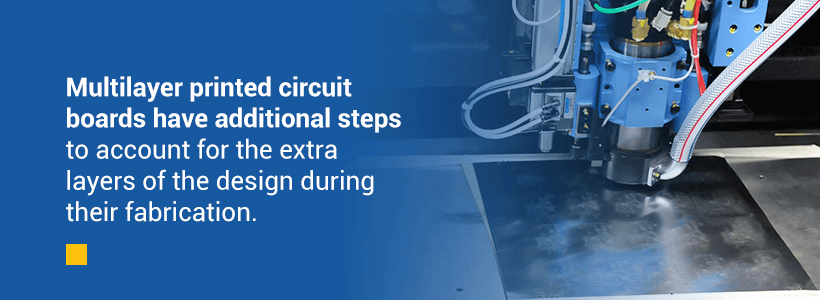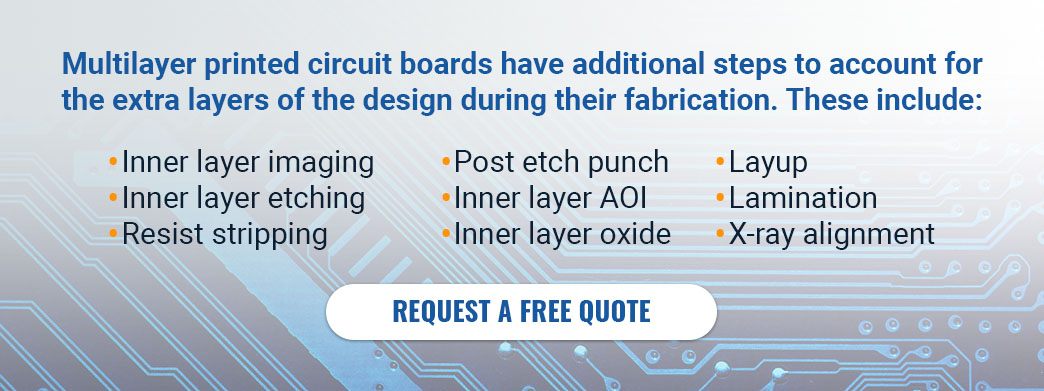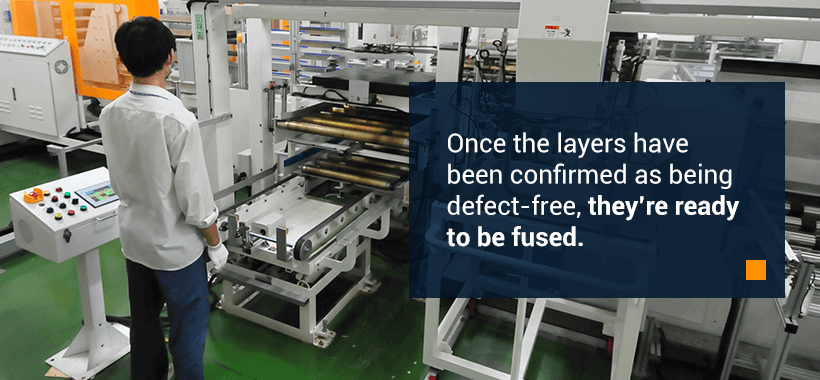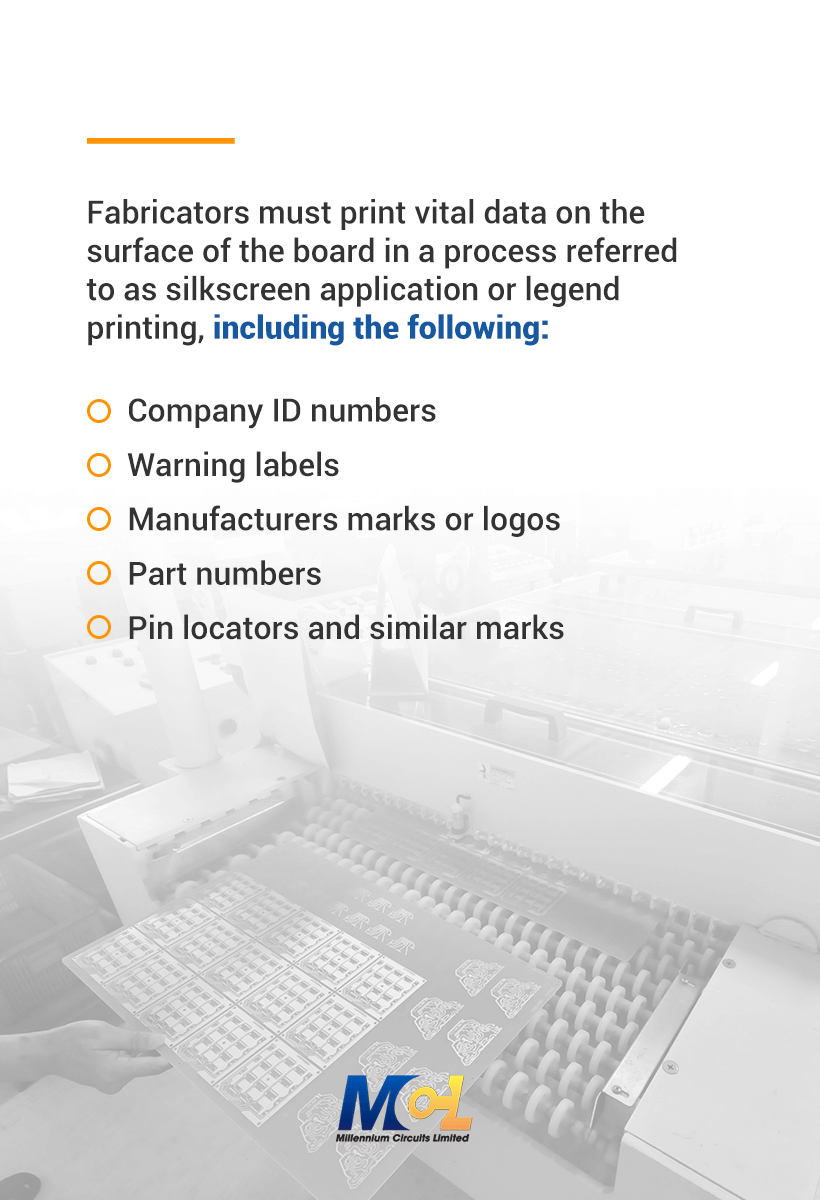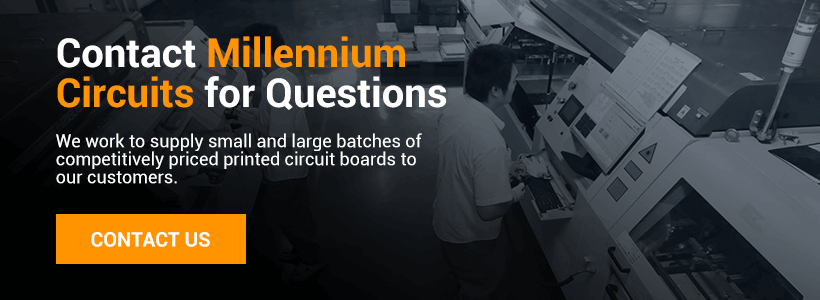Table of Contents:
- Step 1: Designing the PCB
- Step 2: Design Review and Engineering Questions
- Step 3: Printing the PCB Design
- Step 4: Printing the Copper for the Interior Layer
- Step 5: Etch the Inner Layers or Core to Remove Copper
- Step 6: Layer Alignment
- Step 7: Automated Optical Inspection
- Step 8: Laminating the PCB Layers
- Step 9: Drilling
- Step 10: PCB Plating
- Step 11: Outer Layer Imaging
- Step 12: Outer Layer Etching
- Step 13: Outer Layer AOI
- Step 14: Solder Mask Application
- Step 15: Silkscreen Application
- Step 16: Finishing the PCB
- Step 17: Electrical Reliability Test
- Step 18: Profiling and Route Out
- Step 19: Quality Check and Visual Inspection
- Step 20: Packaging and Delivery
What is the PCB Manufacturing Process?
The printed circuit board (PCB) manufacturing process requires a complex procedure to ensure the performance of the finished product. Though circuit boards can be single, double or multilayered, the fabrication processes used only differ after the first layer’s production. Due to differences in the structure of the PCBs, some may require 20 or more steps during manufacturing.
The number of steps required for producing printed circuit boards correlates to their complexity. Skipping any step or cutting back on the procedure could negatively impact the performance of the circuit board. However, when successfully completed, the PCBs should perform their tasks properly as key electronic components.
What Are The Parts of a PCB?
There are four main parts to a PCB:
- Substrate: The first, and most important, is the substrate material, usually made of fiberglass. Fiberglass is used because it provides a core strength to the PCB and helps resist breakage. Think of the substrate as the PCB’s “skeleton”.
- Copper Layer: Depending on the board type, this layer can either be copper foil or a full-on copper coating. Regardless of which approach is used, the point of the copper is still the same — to carry electrical signals to and from the PCB, much like your nervous system carries signals between your brain and your muscles.
- Solder Mask: The third piece of the PCB is the solder mask, which is a layer of polymer that helps protect the copper so that it doesn’t short-circuit from coming into contact with the environment. In this way, the solder mask acts as the PCB’s “skin”.
- Silkscreen: The final part of the circuit board is the silkscreen. The silkscreen is usually on the component side of the board used to show part numbers, logos, symbols switch settings, component reference and test points. The silkscreen can also be known as legend or nomenclature.
Now that we’ve gone over the basics of PCBs and PCB anatomy, we’ll walk through the whole process of how to build a PCB.
How Is a PCB Manufactured?
The steps of the PCB design process start with design and verification and continue through the fabrication of the circuit boards. Many steps require computer guidance and machine-driven tools to ensure accuracy and prevent short circuits or incomplete circuits. The completed boards must undergo strict testing before they are packaged and delivered to customers.
Step One: Designing the PCB
The beginning step of any PCB manufacture is, of course, the design. PCB manufacture and design always start with a plan: the designer lays out a blueprint for the PCB that fulfills all the requirements as outlined. The most commonly-used design software used by PCB designers is a software called Extended Gerber — also known as IX274X.
When it comes to PCB design, Extended Gerber is an excellent piece of software because it also works as an output format. Extended Gerber encodes all the information that the designer needs, such as the number of copper layers, the number of solder masks needed and the other pieces of component notation. Once a design blueprint for the PCB is encoded by the Gerber Extended software, all the different parts and aspects of the design are checked over to make sure that there are no errors.
Once the examination by the designer is complete, the finished PCB design is sent off to a PCB fabrication house so that the PCB can be built. On arrival at the PCB fabrication house, the PCB design plan undergoes a second check by the fabricator, known as a Design for Manufacture (DFM) check. A proper DFM check ensures that the PCB design fulfills, at minimum, the tolerances required for manufacture. Then it’s ready for the next step in the design process: design review and engineering questions.
Step Two: Design Review and Engineering Questions
Another key step of the printed circuit board fabrication process involves checking the design for potential errors or flaws. An engineer performs a design review and goes over every part of the PCB design to ensure there are no missing components or incorrect structures. After getting clearance from an engineer, the design moves to the printing phase.
Step Three: Printing the PCB Design
After all the checks are complete, the PCB design can be printed. Unlike other plans, like architectural drawings, PCB plans don’t print out on a regular 8.5 x 11 sheet of paper. Instead, a special kind of printer, known as a plotter printer, is used. A plotter printer makes a “film” of the PCB. The final product of this “film” looks much like the transparencies that used to be used in schools — it’s essentially a photo negative of the board itself.
The inside layers of the PCB are represented in two ink colors:
- Black Ink: Used for the copper traces and circuits of the PCB
- Clear Ink: Denotes the non-conductive areas of the PCB, like the fiberglass base
On the outer layers of the PCB design, this trend is reversed — clear ink refers to the line of copper pathways, but black ink also refers to areas where the copper will be removed.
Each PCB layer and the accompanying solder mask gets its own film, so a simple two-layer PCB needs four sheets — one for each layer and one each for the accompanying solder mask.
After the film is printed, they’re lined up and a hole, known as a registration hole, is punched through them using a punch machine. The registration hole is used as a guide to align the films later on in the process.
Step Four: Printing the Copper for the Interior Layers
Step four is the first step in the process where the manufacturer starts to make the PCB. After the PCB design is printed onto a piece of laminate material, a copper foil layer or copper coating is applied. The copper is then pre-bonded to that same piece of laminate, which serves as the structure for the PCB. The copper is then etched away to reveal the blueprint from earlier.
Next, the laminate panel is covered by a type of photo-sensitive film called the resist. The resist is made of a layer of photo-reactive chemicals that harden after they’re exposed to ultraviolet light. The resist allows technicians to get a perfect match between the photos of the blueprint and what’s printed to the photoresist.
Once the resist and the laminate are lined up — using the holes from earlier — they receive a blast of UV light. The UV light passes through the translucent parts of the film, hardening the photoresist. This indicates areas of copper that are meant to be kept as pathways. In contrast, the black ink prevents any light from getting to the areas that aren’t meant to harden so that they can later be removed.
Once the board has been prepared, it is washed with an alkaline solution to remove any of the leftover photoresists. The board is then pressure-washed to remove anything left on the surface and left to dry.
After drying, the only resist that should be left on the PCB is on top of the copper that remains as part of the PCB when it’s finally popped free. A technician looks over the PCBs to make that there are no errors. If no errors are present, then it’s on to the next step.
Step Five: Etch the Inner Layers or Core to Remove Copper
The core or inner layers of the printed circuit board need to have extra copper removed before the PCB fabrication process can continue. Etching involves covering the necessary copper on the board and exposing the rest of the board to a chemical. The chemical etching process removes all unprotected copper from the PCB, leaving only the board’s necessary amount.
This step may vary in its time or the amount of copper etching solvent used. Large PCBs or those with heavier structures may use more copper, resulting in more copper that must undergo etching for removal. Therefore, these boards will require extra time or solvent.
If a Printed Circuit Board Manufacturing Process Is for Multilayer Designs
Multilayer printed circuit boards have additional steps to account for the extra layers of the design during their fabrication. These steps mirror many of those used during single layer PCBs. However, the phases repeat for each layer of the board. Also, in multilayer PCBs, copper foil typically replaces copper coating between the layers.
Inner Layer Imaging
Inner layer imaging follows the same procedures as printing the PCB design. The design prints on a plotter printer to create a film. The solder mask for the inner layer also prints out. After aligning both, a machine creates a registration hole in the films to help keep the films lined up properly with the layers later.
After adding copper to the laminate material for the inner layer, technicians place the printed film over the laminate and align them using the registration holes.
Ultraviolet light exposes the film, also known as the resist, to harden the chemicals of the light-colored areas into the printed pattern. These hardened areas will not wash off during the etching phase, while the non-hardened areas under dark-colored film will have their copper removed.
Inner Layer Etching
After imaging, the areas covered by white ink have hardened. This hardened material protects the copper beneath that will remain on the board after etching.
Technicians first wash off the board with alkaline to remove any remaining resist from the board that didn’t harden. This cleaning exposes areas that covered non-conductive portions of the printed circuit board. Next, workers will etch off the excess copper from these non-conductive areas by submerging the board into a copper solvent to dissolve the exposed copper.
Resist Stripping
The resist stripping step removes any remaining resist covering the copper of the PCB inner layer. Cleaning any resist remaining ensures the copper will not have anything to hamper its conductivity. After removing the resist, the layer is ready to undergo inspection of its basic design.
Post Etch Punch
The post-etch punch aligns the layers and punches a hole through them using the registration holes as a guide. As with the subsequent inspection of this hole and alignment, the punching happens from a computer that exactly guides a machine known as an optical punch. After the optical punch, the layers move to the inner layer automated optical inspection (AOI).
Inner Layer AOI
Inner layer automated optical inspection uses a computer to carefully examine the inner layer to look for incomplete patterns or resist that may still be on the surface. If the PCB layer passes AOI, it moves on in the process.
Inner Layer Oxide
Oxide applied to the inner layer ensures better bonding of the copper foil and insulating epoxy resin layers between inner and outer layers.
Layup
The layup step in the multilayer PCB fabrication process happens when a machine helps to line up, heat and bond the layers together with a copper foil layer and insulating material between the inner and outer layers. Typically, computers guide these machines because the alignment of the layers and bonding must be exact for the printed circuit board’s proper structure.
Lamination
Lamination uses heat and pressure to melt the bonding epoxy between the layers. Properly laminated PCBs will hold their layers tightly together with effective insulation between layers.
X-Ray Alignment
When drilling multilayer boards after lamination, an X-ray ensures alignment of the drill bit. These holes allow for connections to occur between layers of the multilayer PCB. Therefore, the accuracy of their placement and size in relation to the rest of the layer and the other layers is crucial. Following the layers’ X-ray alignment, the printed circuit board undergoes drilling, picking up with step nine of single or double-sided PCB board fabrication.
Step Six: Layer Alignment
After each of the PCB’s layers has been cleaned, they’re ready for layer alignment and optical inspection. The holes from earlier are used to align the inner and outer layers. To align the layers, a technician places them on a type of punch machine known as an optical punch. The optical punch drives a pin down through the holes to line up the layers of the PCB.
Step Seven: Automated Optical Inspection
Following the optical punch, another machine performs an optical inspection to make sure there are no defects. This automated optical inspection is incredibly important because once the layers are placed together, any errors that exist can’t be corrected. To confirm that there are no defects, the AOI machine compares the PCB with the Extended Gerber design, which serves as the manufacturer’s model.
After the PCB has passed the optical inspection — that is, neither the technician nor the AOI machine found any defects — it moves onto the last couple steps of PCB manufacture and production.
The AOI step is crucial for the operation of the printed circuit board. Without it, boards that could have short circuits, not meet the design specifications or have extra copper that was not removed during etching could pass through the rest of the process. AOI prevents defective boards from going on by serving as a quality checkpoint midway through the production process. Later, this process repeats for the outer layers after engineers finish imaging and etching them.
Step Eight: Laminating the PCB Layers
At step six in the process, the PCB layers are all together, waiting to be laminated. Once the layers have been confirmed as being defect-free, they’re ready to be fused. The PCB laminating process is done in two steps: the lay-up step and the laminating step.
The outside of the PCB is made of pieces of fiberglass that have been pre-soaked/pre-coated with an epoxy resin. The original piece of the substrate is also covered in a layer of thin copper foil that now contains the etchings for the copper traces. Once the outer and inner layers are ready, it’s time to push them together.
The sandwiching of these layers is done using metal clamps on a special press table. Each layer fits onto the table using a specialized pin. The technician doing the laminating process starts by placing a layer of pre-coated epoxy resin known as pre-impregnated or prepreg — on the table’s alignment basin. A substrate layer is placed over the pre-impregnated resin, followed by a copper foil layer. The copper foil is in turn followed by more sheets of pre-impregnated resin, which are then finished off with a piece of and one last piece of copper known as a press plate.
Once the copper press plate is in place, the stack is ready to be pressed. The technician takes it over to a mechanical press and presses the layers down and together. As part of this process, pins are then punched down through the stack of layers to ensure that they’re fixed properly.
If the layers are fixed properly, the PCB stack is taken to the next press, a laminating press. The laminating press uses a pair of heated plates to apply both heat and pressure to the stack of layers. The plates’ heat melts the epoxy inside of the prepeg — it, and the pressure from the press combine to fuse the stack of PCB layers together.
Once the PCB layers are pressed together, there’s a little bit of unpacking that needs to be done. The technician needs to remove the top press plate and the pins from earlier, which then allows them to pull the actual PCB free.
Steps Nine: Drilling
Before drilling, an X-ray machine is used to locate the drill spots. Then, registration/guiding holes are drilled so that the PCB stack can be secured before the more specific holes are drilled. When it comes time to drill these holes, a computer-guided drill is used to make the holes themselves, using the file from the Extended Gerber design as a guide.
Once the drilling is complete, any additional copper that’s leftover at the edges is filed off.
Steps Ten: PCB Plating
After the panel has been drilled, it’s ready to be plated. The plating process uses a chemical to fuse all of the different layers of the PCB together. After being cleaned thoroughly, the PCB is bathed in a series of chemicals. Part of this bathing process coats the panel in a micron-thick layer of copper, which is deposited over the top-most layer and into the holes that have just been drilled.
Before the holes are filled with copper, they simply serve to expose the fiberglass substrate that makes up the panel’s insides. Bathing those holes in copper covers the walls of the previously drilled holes.
Step Eleven: Outer Layer Imaging
Earlier in the process (Step Four), a photoresist was applied to the PCB panel. In Step Eleven, it’s time to apply another layer of photoresist. However, this time the photoresist is only applied to the outside layer, since it still needs to be imaged. Once the outer layers have been coated in photoresist and imaged, they’re plated in the exact same way the interior layers of the PCB were plated in the previous step. However, while the process is the same, the outer layers get a plating of tin to help guard the copper of the outside layer.
Step Twelve: Outer Layer Etching
When it comes time to etch the outside layer for the last time, the tin guard is used to help protect the copper during the etching process. Any unwanted copper is removed using the same copper solvent from earlier, with the tin protecting the valued copper of the etching area.
One of the main differences between the inner and outer layer etching covers the areas that need removal. While inner layers use dark ink for conductive areas and clear ink for non-conductive surfaces, these inks are reversed for the outer layers. Therefore, the non-conductive layers have dark ink covering them, and the copper has light ink. This light ink allows for the tin plating to cover the copper and protect it. Engineers remove unneeded copper and any remaining resist coating during etching, preparing the outer layer for AOI and solder masking.
Steps Thirteen: Outer Layer AOI
As with the inner layer, the outer layer must also undergo automated optical inspection. This optical inspection ensures the layer meets the exact requirements of the design. It also verifies that the previous step removed all extra copper from the layer to create a properly functioning printed circuit board that won’t create improper electrical connections.
Steps Fourteen: Solder Mask Application
Panels require a thorough cleaning before the solder mask application. Once clean, each panel has an ink epoxy and solder mask film covering the surface. Next, ultraviolet light strikes the boards to indicate where the solder mask needs removal.
Once technicians take off the solder mask, the circuit board goes into an oven to cure the mask. This mask provides the board’s copper with extra protection from damage caused by corrosion and oxidation.
Step Fifteen: Silkscreen Application & Surface Finish Application
Because PCBs need to have information directly on the board, fabricators must print vital data on the surface of the board in a process referred to as silkscreen application or legend printing. This information includes the following:
- Company ID numbers
- Warning labels
- Manufacturers marks or logos
- Part numbers
- Pin locators and similar marks
After printing the above information onto the printed circuit boards, often with an inkjet printer, the PCBs have their surface finish applied. Then, they continue to the testing, cutting and inspection phases.
Step Sixteen: Finishing the PCB
Finishing the PCB requires plating with conductive materials, such as the following:
- Immersion silver: Low signal loss, lead-free, RoHS compliant, the finish can oxidize and tarnish
- Hard gold: Durable, long shelf life, RoHS compliant, lead-free, expensive
- Electroless nickel immersion gold (ENIG): One of the most common finishes, long shelf life, RoHS compliant, more expensive than other options
- Hot air solder leveling (HASL): Cost-effective, long-lasting, reworkable, contains lead, not RoHS compliant
- Lead-free HASL: Cost-effective, lead-free, RoHS compliant, reworkable
- Immersion tin (ISn): Popular for press-fit applications, tight tolerances for holes, RoHS compliant, handling the PCB can cause soldering problems, tin whiskers
- Organic solderability preservative (OSP): RoHS compliant, cost-effective, short shelf life
- Electroless nickel electroless palladium immersion gold (ENEPIG): High solder strength, reduces corrosion, requires careful processing for proper performance, less cost-effective than options that don’t use gold or palladium
The correct material depends on the design specifications and the customer’s budget. However, applying such finishes creates an essential trait for the PCB. The finishes allow an assembler to mount electronic components. The metals also cover the copper to protect it from oxidation that can occur with exposure to air.
Step Seventeen: Electrical Reliability Test
After the PCB has been coated and cured (if necessary), a technician performs a battery of electrical tests on the different areas of the PCB to ensure functionality. Electrical testing must adhere to the standards of IPC-9252, Guidelines and Requirements for Electrical Testing of Unpopulated Printed Boards. The main tests that are performed are circuit continuity and isolation tests. The circuit continuity test checks for any disconnections in the PCB, known as “opens.” On the other hand, the circuit isolation test checks the isolation values of the PCB’s various parts to check if there are any shorts. While the electrical tests mainly exist to ensure functionality, they also work as a test of how well the initial PCB design stood up to the manufacturing process.
In addition to basic electrical reliability testing, there are other tests that can be used to determine if a PCB is functional. One of the main tests used to do this is known as the “bed of nails” test. During this text, several spring fixtures are attached to the test points on the circuit board. The spring fixtures then subject the test points on the circuit board with up to 200g of pressure to see how well the PCB stands up to high-pressure contact at its test points.
If the PCB has passed its electrical reliability testing — and any other testing the manufacturer chooses to implement — it can be moved on to the next step: route out and inspection.
Step Eighteen: Profiling and Route Out
Profiling requires fabrication engineers to identify the shape and size of the individually printed circuit boards cut from the construction board. This information typically is in the design’s Gerber files. This profiling step guides the routing out process by programming where the machine should create the scores on the construction board.
Routing out, or scoring, allows for easier separation of the boards. A router or CNC machine creates several small pieces along the edges of the board. These edges can let the board quickly break off without damage.
However, some fabricators may choose to use a v-groove instead. This machine will create v-shaped cuts along the sides of the board.
Both options for scoring the PCBs will allow the boards to separate cleanly without the boards cracking. After scoring the boards, the fabricators break them from the construction board to move them to the next step.
Step Nineteen: Quality Check and Visual Inspection
After scoring and breaking the boards apart, the PCB must undergo one final inspection before packaging and shipping. This final check verifies several aspects of the boards’ construction:
- The hole sizes must match on all layers and meet the design requirements.
- Board dimensions must align to those in the design specifications.
- Fabricators must assure cleanliness that the boards do not have dust on them.
- Finished boards cannot have burrs or sharp edges.
- All boards that failed electrical reliability tests must undergo repair and retesting.
Step Twenty: Packaging and Delivery
The last stage of PCB manufacturing is packaging and delivery. Packaging typically involves material that seals around the printed circuit boards to keep out dust and other foreign materials, similar to vacuum packaging. The sealed boards then go into containers that protect them from damage during shipping. Lastly, they go out for delivery to the customers.
How to Implement an Effective PCB Manufacturing Process
Often the design and fabrication processes of PCB manufacturing have different entities behind them. In many cases, the contract manufacturer (CM) may fabricate a printed circuit board based on the design created by the original equipment manufacturer (OEM). Collaboration on components, design considerations, file formats and board materials between these groups will ensure an effective process and seamless transition between phases.
Components
The designer should consult with the fabricator on available components. Ideally, the fabricator will have all components required by the design on hand. If something is missing, the designer and fabricator will need to find a compromise to ensure faster manufacturing while still meeting minimum design specifications.
Design for Manufacturing (DFM) Considerations
Design for manufacturing considers how well the design can progress through the various stages of the fabrication process. Often the fabricator, usually the CM, will have a set of DFM guidelines for their facility that the OEM can consult during the design phase. The designer can request these DFM guidelines to inform their PCB design to adapt to the fabricator’s production process.
File Formats
Communication between the OEM and CM is crucial to ensure the complete fabrication of the PCB to the OEM’s design specifications. Both groups must use the same file formats for the design. Doing so will prevent errors or lost information that may occur in cases when the files must change formats.
Board Materials
OEMs may design printed circuit boards with pricier materials than the CM anticipates. Both parties must agree to the materials on hand and what will work best for the PCB design while remaining cost-effective for the final purchaser.
Contact Millennium Circuits for Questions
High-quality engineering and manufacturing of PCBs are critical components of the operations of the circuit boards in electronics. Understanding the complexities of the process and why each step must occur gives you a better appreciation for the cost and effort put into each printed circuit board.
When your company needs PCBs for any job, contact us at Millennium Circuits Limited. We work to supply small and large batches of competitively priced printed circuit boards to our customers.



